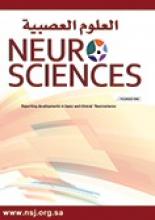Abstract
OBJECTIVE: To demonstrate the differences in the patterns of adult attention deficit/hyperactivity disorder (ADHD) symptoms among non, light, and heavy smokers.
METHODS: A cross-sectional study involving 400 medical students (representing first to sixth year students) was conducted in the Department of Pharmacology, University of Al-Mustansiriya, Baghdad, Iraq from March to June 2011. The medical students completed a questionnaire containing the adult ADHD self-report scale (ASRS-screener) and the Fagerstrom Test for Nicotine Dependence (FTND). An ADHD score ≥14 was considered positive. An FTND score ≥6 signifies heavy smokers, and an FTND score ≤5 signifies light smokers.
RESULTS: Three hundred and sixty-one medical students completed the questionnaire, 16.6% reported ADHD symptoms (19.8% male, 12.1% females). Forty-five percent of ADHD adults were smokers; more than half of them were categorized as heavy smokers (51.8%). In comparison with non-smokers, heavy smokers displayed significant deterioration in their inattentive and total ASRS score (p=0.0001). Light smokers show significantly higher hyperactive symptoms in comparison with non-smokers (p=0.041). A high FTND score was associated with severer deterioration in inattentive (r=0.391, p=0.001) but not hyperactive symptoms (r=0.153, p=0.117).
CONCLUSION: The ADHD symptoms are highly prevalent among Iraqi medical students, and smoking among ADHD students is higher and heavier than non-ADHD controls. Heavy smoking tends to deteriorate rather than ameliorate (self-medicate) ADHD symptoms.
- Copyright: © Neurosciences
Neurosciences is an Open Access journal and articles published are distributed under the terms of the Creative Commons Attribution-NonCommercial License (CC BY-NC). Readers may copy, distribute, and display the work for non-commercial purposes with the proper citation of the original work.






